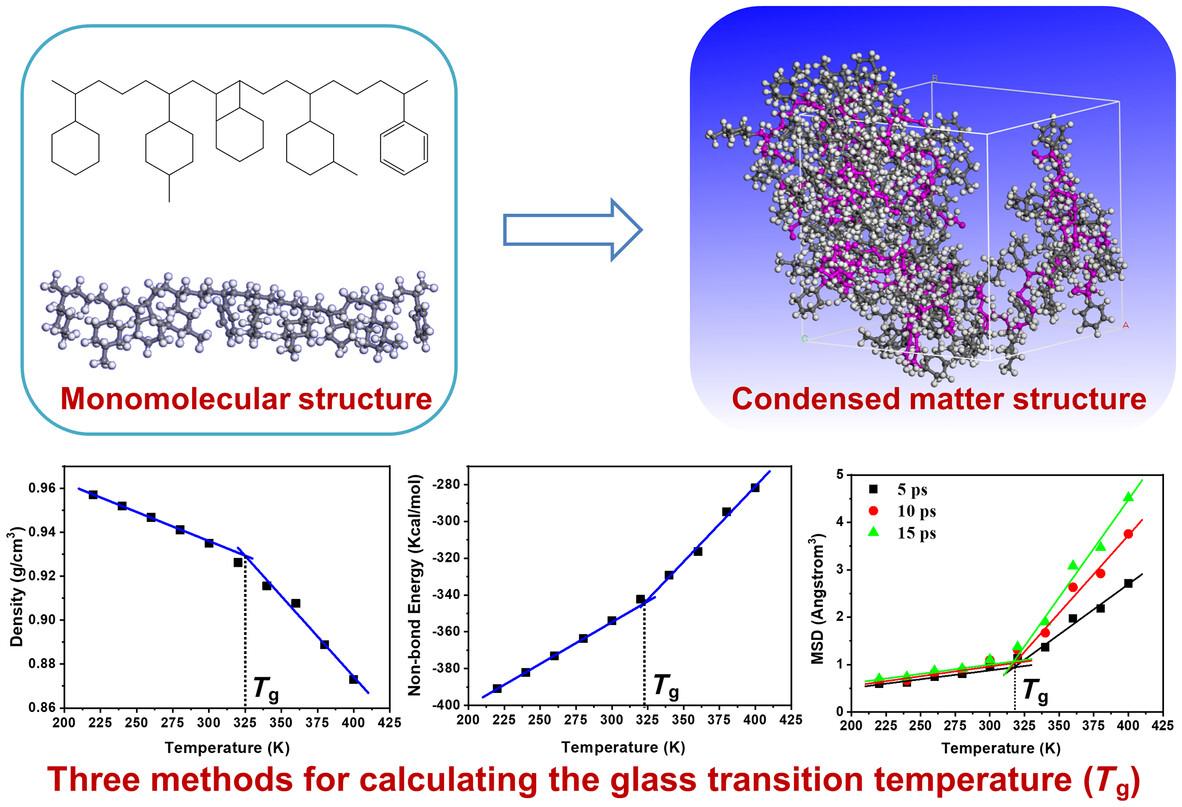Predicting the glass transition temperature and solubility parameter between rubber/silica and rubber/resins via all-atom molecular dynamics simulation
Qionghai Chen, Ziyi Zhang, Wanhui Huang, JiaJun Qu, Qi Zhang, Xiaohui Wu, Liqun Zhang, Jun Liu
求助PDF
{"title":"Predicting the glass transition temperature and solubility parameter between rubber/silica and rubber/resins via all-atom molecular dynamics simulation","authors":"Qionghai Chen, Ziyi Zhang, Wanhui Huang, JiaJun Qu, Qi Zhang, Xiaohui Wu, Liqun Zhang, Jun Liu","doi":"10.1002/pi.6647","DOIUrl":null,"url":null,"abstract":"<p>Resin is a widely used additive in rubber composites, which not only improves the processing properties of the composites but also enhances their mechanical properties, rolling resistance and wear resistance. However, there are specific differences in compatibility among resin, rubber and silica, which directly affect the performance of the composite materials. In this work, we first computed the glass transition temperature (<span></span><math>\n <mrow>\n <msub>\n <mi>T</mi>\n <mi>g</mi>\n </msub>\n </mrow></math>) of five resins in styrene−butadiene rubber (SBR) composites to prove the reliability of the computational method. Then, we explored the effects of different components and resin types on <span></span><math>\n <mrow>\n <msub>\n <mi>T</mi>\n <mi>g</mi>\n </msub>\n </mrow></math> of SBR and found that the addition of silica can increase <span></span><math>\n <mrow>\n <msub>\n <mi>T</mi>\n <mi>g</mi>\n </msub>\n </mrow></math> due to weak attractive interactions between silica and rubber molecular chains, which restrict the movement of the molecular chains. Furthermore, using solubility parameters, we analyzed the compatibility of rubber and five different resins and found that all five resins had good compatibility with rubber, especially C5/C9 copolymerized petroleum resin and hydrogenated resin. Finally, we revealed that there is a mutually attractive force between resin and silica. In summary, understanding the interactions among resins, silica and rubber is crucial for optimizing the performance of composite materials. © 2024 Society of Chemical Industry.</p>","PeriodicalId":20404,"journal":{"name":"Polymer International","volume":"73 9","pages":"770-778"},"PeriodicalIF":2.9000,"publicationDate":"2024-05-10","publicationTypes":"Journal Article","fieldsOfStudy":null,"isOpenAccess":false,"openAccessPdf":"","citationCount":"0","resultStr":null,"platform":"Semanticscholar","paperid":null,"PeriodicalName":"Polymer International","FirstCategoryId":"92","ListUrlMain":"https://onlinelibrary.wiley.com/doi/10.1002/pi.6647","RegionNum":4,"RegionCategory":"化学","ArticlePicture":[],"TitleCN":null,"AbstractTextCN":null,"PMCID":null,"EPubDate":"","PubModel":"","JCR":"Q2","JCRName":"POLYMER SCIENCE","Score":null,"Total":0}
引用次数: 0
引用
批量引用
Abstract
Resin is a widely used additive in rubber composites, which not only improves the processing properties of the composites but also enhances their mechanical properties, rolling resistance and wear resistance. However, there are specific differences in compatibility among resin, rubber and silica, which directly affect the performance of the composite materials. In this work, we first computed the glass transition temperature (
T
g
) of five resins in styrene−butadiene rubber (SBR) composites to prove the reliability of the computational method. Then, we explored the effects of different components and resin types on
T
g
of SBR and found that the addition of silica can increase
T
g
due to weak attractive interactions between silica and rubber molecular chains, which restrict the movement of the molecular chains. Furthermore, using solubility parameters, we analyzed the compatibility of rubber and five different resins and found that all five resins had good compatibility with rubber, especially C5/C9 copolymerized petroleum resin and hydrogenated resin. Finally, we revealed that there is a mutually attractive force between resin and silica. In summary, understanding the interactions among resins, silica and rubber is crucial for optimizing the performance of composite materials. © 2024 Society of Chemical Industry.
通过全原子分子动力学模拟预测橡胶/二氧化硅和橡胶/树脂之间的玻璃化转变温度和溶解度参数
树脂是橡胶复合材料中广泛使用的添加剂,它不仅能改善复合材料的加工性能,还能提高其机械性能、滚动阻力和耐磨性。然而,树脂、橡胶和二氧化硅之间的相容性存在具体差异,直接影响复合材料的性能。在这项工作中,我们首先计算了丁苯橡胶(SBR)复合材料中五种树脂的玻璃化转变温度(),以证明计算方法的可靠性。然后,我们探讨了不同成分和树脂类型对丁苯橡胶玻璃化转变温度的影响,发现二氧化硅的加入会增加玻璃化转变温度,这是因为二氧化硅与橡胶分子链之间存在微弱的吸引力相互作用,限制了分子链的运动。此外,我们利用溶解度参数分析了橡胶与五种不同树脂的相容性,发现这五种树脂都与橡胶有良好的相容性,尤其是 C5/C9 共聚石油树脂和氢化树脂。最后,我们发现树脂和白炭黑之间存在相互吸引的作用力。总之,了解树脂、二氧化硅和橡胶之间的相互作用对于优化复合材料的性能至关重要。© 2024 化学工业协会。
本文章由计算机程序翻译,如有差异,请以英文原文为准。



